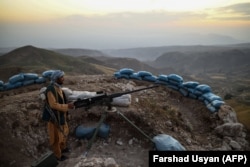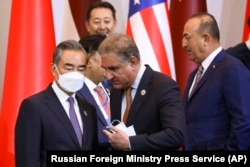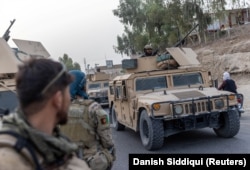As U.S. troops draw down in Afghanistan, Chinese officials have stepped up contacts with the Taliban as it surges across the country and builds strategic footholds against Afghan government forces.
On paper, Beijing and the Taliban are strange bedfellows.
China is an atheistic, communist state that is running an internment camp system in its western Xinjiang Province that is believed to have detained more than 1 million Uyghurs and other Muslim minorities. The Taliban, meanwhile, is a fundamentalist militant group that previously governed Afghanistan as an Islamic caliphate.
So what’s driving the two sides together?
While there is little shared ideology, both sides are managing to forge a transactional relationship based on mutual self-interest.
China -- which is positioning itself to play a defining role in the region -- sees the group as an undeniable part of Afghanistan’s political future, while the Taliban views Beijing as crucial for its international legitimacy and a much-needed potential investor in the country.
In recent weeks, Taliban representatives have said China is a “welcome friend” in Afghanistan and gone out of their way to signal that they will not interfere in Beijing's domestic affairs, while promising that territory under the Islamist groups’ control would not be used against other countries.
This outreach may seem abrupt but is actually the product of a complicated, decades-old relationship that experts say is defined by pragmatism and an underlying distrust of the other. As the political reality in Afghanistan continues to shift quickly, both Beijing and the Taliban are looking to explore how closely they can cooperate.
“There’s a lot of skepticism of one another in this dynamic,” Raffaello Pantucci, a senior associate fellow at London's Royal United Services Institute, told RFE/RL. “The foundation of it is that each side views the other as a means to an end.”
Why Are They Talking Now?
Stability, specifically its own, is the top concern for China.
Central to Chinese worries in Afghanistan is the country once again becoming a haven for extremist groups with international ambitions like Al-Qaeda and the Islamic State. Beijing is particularly focused on Uyghur militants that have their sights set on China and could cross the country's 76-kilometer border with Afghanistan.
Ensuring that fighting or chaos from a potential power vacuum won’t spill over is paramount to Chinese policymakers.
The existence of Uyghur extremist groups -- based in Afghanistan and elsewhere -- have been part of Beijing’s justification for its sweeping dragnet against Muslim minorities in neighboring Xinjiang.
The Taliban’s recent gains indicate it could well be part of Afghanistan’s political equation or perhaps topple the government in Kabul. With this in mind, Beijing has moved to engage the Taliban to ensure that its security interests will be protected.
“The Chinese can see that the Taliban are likely to cement power and Beijing also doesn’t want to get sucked in and overextended in Afghanistan, so that means they need to have a working relationship with the Taliban,” Pantucci said.
The militant group has taken Chinese concerns to heart and tried to show goodwill, calling for talks on reconstruction and drawing in Chinese investment to begin as soon as possible.
The Taliban has also signaled that it has little current interest in getting involved with events in Xinjiang.
“We care about the oppression of Muslims, be it in Palestine, in Myanmar, or in China, and we care about the oppression of non-Muslims anywhere in the world,” a senior Taliban representative told The Wall Street Journal. “But what we are not going to do is interfere in China’s internal affairs.”
Can Beijing Work With The Taliban?
This isn’t the first time the two sides have been pushed together by events on the ground in Afghanistan.
In the late 1990s, China decided that the best way to manage a potential extremist threat from the country was to engage with the Taliban.
In 1999, a group of Chinese officials flew to Kabul and opened diplomatic and economic relations, with China’s ambassador to Pakistan seeking a meeting with Taliban commander Mullah Omar.
That meeting took place in 2000, at which Beijing pressed Omar to stop harboring ethnic Uyghur militants allegedly operating in Afghanistan with a group called the East Turkestan Islamic Movement (ETIM). In exchange, the Taliban hoped China would provide diplomatic support at the United Nations and help roll back sanctions placed on the group.
While analysts say Mullah Omar did restrain ETIM in the country, he did not expel the group. No deal with Beijing on the matter was ever formalized, and the Taliban was pushed out of Kabul following the September 11, 2001, terrorist attacks and the invasion of Afghanistan.
“There’s always been a level of mistrust that the Chinese have toward the Taliban,” Andrew Small, a fellow with the German Marshall Fund, told RFE/RL. “Regardless of what deals they strike and whether they are kept, [Beijing] is also concerned that the group’s success could provide inspiration to other groups.”
Following the U.S.-led invasion of Afghanistan in late 2001, the Taliban’s top leadership relocated to Pakistan. According to Small, Islamabad -- the group’s chief patron and a close Beijing ally -- helped facilitate Chinese-Taliban ties over the following years.
Those talks picked up steam in more recent years and once again centered on the Taliban denying Uyghur militants safe haven and curbing the activities of ETIM.
Starting in 2014, Taliban delegations began to publicly and regularly visit China, culminating in secret talks that China facilitated between Kabul and the Taliban in Urumqi, the capital of Xinjiang.
“The Taliban have been dealing with the Chinese for decades now and [the militants understand] their concerns,” said Small. “It’s an unusual relationship, but it's been one of the Taliban’s most consistent since it's been in exile in Pakistan.”
What Is ETIM?
Central to Beijing’s engagement with the Taliban are concerns over Uyghur militants -- specifically ETIM -- gaining a home base in Afghanistan.
But the group has a complex and disputed history. While Uyghur militants do operate in Afghanistan, their size and sophistication has been a source of disagreement among analysts and governments.
As George Washington University’s Sean R. Roberts writes in his book, The War On The Uyghurs, no group ever used the name ETIM, but it became associated with a small band of Uyghur militants who relocated to Afghanistan in the late 1990s with the goal of launching attacks against Beijing’s rule in Xinjiang.
Beijing would go on to accuse the group of helping to orchestrate attacks inside China and, in 2002, as the U.S.-led war on terror was ramping up, the group was officially recognized by Washington as a terrorist organization.
Little was heard from the group throughout the 2000s, especially after its leader was killed in 2003, until a group calling itself the Turkestan Islamic Party (TIP) issued an online video in 2008 in which it threatened to attack China during that year's Summer Olympics. TIP said it was a successor to ETIM, although Beijing still refers to it by the older name.
TIP has since developed into a larger militant group based in Syria, but as Roberts wrote for The Guardian in 2020, “there is no evidence that this group has ever orchestrated violence inside China itself.”
This has led critics to accuse Beijing of exaggerating the connections between militant groups and developments in China in order to justify its repressive policies against Uyghurs and the ongoing crackdown on Muslims in Xinjiang.
As Beijing currently engages in talks with the Taliban with a focus on Uyghur militants, several hundred fighters are believed to be in Afghanistan, according to a 2020 United Nations Security Council report.
But the administration of President Donald Trump removed ETIM from its terrorist organization list in 2020, saying it believed there was “no credible” evidence the group still existed.
What Is China’s Game Plan?
Despite its growing ties with the Taliban, Beijing still recognizes President Ashraf Ghani’s government and has also engaged with Kabul in monitoring Uyghur militants in Afghanistan.
Beyond security, Beijing also has some longer-term economic hopes for the country, with Chinese firms involved in the massive Aynak copper mine and exploration in the Amu Darya oil field.
For the time being, however, China is looking to strengthen its relations with both sides and use that leverage to push for a political solution between Kabul and the Taliban. Beijing is also dangling future investment and deeper efforts to integrate Afghanistan into its Belt and Road Initiative as a way to bring both sides to the negotiating table.
“It’s one of the few levers that China has to push for a stable political settlement in the country,” Small said.
Those strengthened ties give Beijing a special role to play in any future peace process, Chinese Foreign Minister Wang Yi said in Dushanbe, Tajikistan, on July 13 during a tour of Central Asia.
China has also stepped up its security engagement and cooperation with Afghanistan’s neighbors in Central Asia, as well as with Pakistan, as part of what Pantucci calls a “hedging strategy” to prepare for any possible outcome from the current situation in the country.
“The Chinese are negotiating with the Taliban, and the Taliban are being receptive so far,” he said. "But the Chinese have actually built themselves an insurance policy by building a strong regional security presence [to cover]" for any outcome.










